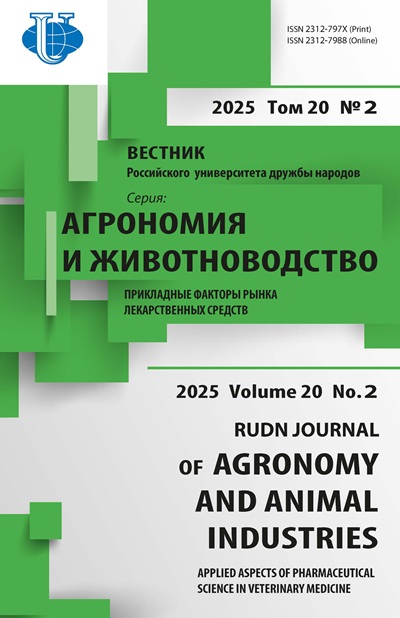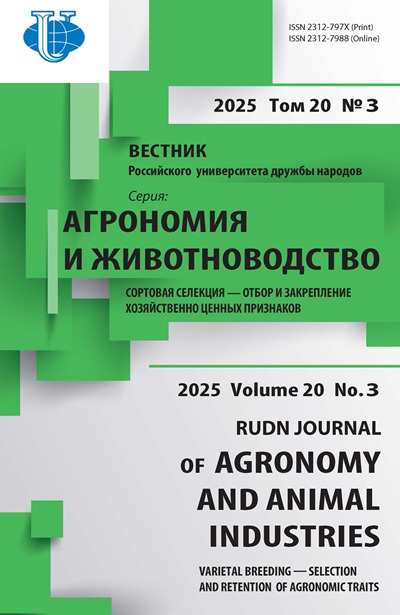Vol 20, No 3 (2025): Varietal breeding — selection and retention of agronomic traits
- Year: 2025
- Articles: 13
- URL: https://agrojournal.rudn.ru/agronomy/issue/view/1134
- DOI: https://doi.org/10.22363/2312-797X-2025-20-3
Full Issue
Varietal breeding — selection and retention of agronomic traits
 341-343
341-343


Marker selection of promising varietal and breeding material of apple tree
Abstract
Apple tree ( Malus × domestica Borkh.) is a leading agricultural pome crop, one of the main perennial fruit plants in the world, commercially in demand and widespread in the horticultural industry of Russia, including the North Caucasus region. In solving the problem of creating high-quality domestic apple varieties with a long-term type of resistance to the scab (pathogen - Venturia inaequalis (Cooke) G. Winter), the role of prebreeding, including research aimed at accelerated selection using the DNA method, is significant tagging valuable carriers of several Rvi scab resistance genes. The purpose of the study was to study the allelic polymorphism of 15 apple tree scab resistance genes ( Venturia inaequalis (Cooke) G. Winter) in 33 varietal and breeding samples of apple trees to identify sources of long-term resistance to increase efficiency of breeding process. The research was carried out in accordance with programs and methods for the study of apple varieties; Research and Selection Collection of Genetic Resources of Horticultural Crops and the Instrumentation and Analytical Center were used. DNA analysis methods were used in this work. For DNA extraction, a modification of the CTAB method was used, developed at North Caucasian Federal Scientific Center of Horticulture, Viticulture, Winemaking, allowing for better purification of DNA samples from polyphenolic compounds. The work used 22 markers to identify 15 apple scab resistance genes: Rvi1; Rvi2; Rvi3; Rvi4; Rvi5; Rvi6; Rvi8; Rvi9; Rvi11; Rvi12; Rvi13; Rvi14; Rvi15; Rvi16; Rvi17 . Marker selection of new varietal and breeding material made it possible to identify carriers of several genes for apple tree resistance to scab, having in the genome from 2 to 6 different Rvi genes in different combinations. Carriers of 6 resistance genes were identified as the most promising for selection for long-term resistance to scab: Rvi1, Rvi2, Rvi3, Rvi4, Rvi6, Rvi15-1 2/1-21-24; 5 genes: Rvi1, Rvi2, Rvi3, Rvi6, Rvi13 - Karmen; Rvi1, Rvi2, Rvi4, Rvi6, Rvi15 - Mikhsan; 4 genes: Rvi1, Rvi2, Rvi3, Rvi6 - Nadezhnoye; Rvi1, Rvi4, Rvi6, Rvi15 - Gaito Gazdanov; Rvi1, Rvi3, Rvi6, Rvi8-1 2/1-20-56, etc. Identified apple genotypes of domestic breeding, including those created in creative collaboration with colleagues from the Russian Research Institute for Breeding Fruit Crops and Stavropol Experimental Horticulture Station, promising for further breeding and accelerated creation of new high-quality, adaptive varieties with long-term high potential for resistance to the main fungal pathogen of the crop.
 344-353
344-353


Resistance of spring wheat Triticum aestivum L. to leaf rust under the conditions of the Central Non-Black-Earth region
Abstract
The results of experimental studies on field resistance of spring common wheat ( Triticum aestivum L . ) varieties to leaf rust in the Central Region of the Non-Black Soil Zone of Russia were described. Fifteen spring wheat varieties were evaluated under field conditions from 2021 to 2024. The study aimed to analyze the yield performance of these varieties depending on the effectiveness of resistance genes (Lr genes) against leaf rust in the Central Non-Black Earth region of Russia. A search for relevant publications and identification of Lr genes in the varieties was conducted using databases such as Wheatpedigree, Scopus, NCBI, PubMed, Google Scholar, RSCI, and Cyberleninka. Resistance to brown rust was assessed using the 9-point VIR scale. The results showed that in years with favorable weather conditions from sprouting to heading, resistance to leaf rust positively influenced grain yield. However, during drought periods, this resistance had no significant effect on yield. Lr resistance genes in the studied varieties provided relatively effective protection in years with low infection pressure, but were insufficient during epidemic years. Therefore, more effective genes or their combinations should be considered when developing new varieties for the Central Non-Black Earth region of Russia. The most effective resistance genes identified from 2021 to 2024 were Lr19 + Lr6 (from the donor variety Tulaykovskaya 108) and Lr21 (from the donor variety Granny).
 354-367
354-367


Characteristics of selection traits in new accessions of spring barley Hordeum vulgare L. in the conditions of North-West Russia
Abstract
The research was conducted in 2020-2021 at Leningrad Research Institute ‘Belogorka’ - a branch of Russian Potato Research Centre, located in the village of Belogorka, Gatchina district, Leningrad region. The research was carried out to identify sources of economically valuable traits from the collection of Vavilov AllRussian Institute of Plant Genetic Resources on the main elements of crop structure to create valuable breeding material for spring barley. In accordance with the Methodological Guidelines for the Study and Preservation of the World Collection of Barley and Oats (2012) and the International comecon list of descriptors for genus Hordeum L. (1983), 17 new spring barley cultivars of different ecological and geographical origins were studied over two years. Two cultivars were used as standards - Suzdalets (by yield) selected by several organizations and Leningradsky (by early ripening) selected by Leningrad Research Agricultural Institute ‘Belogorka’. The standard cv. Leningradsky surpassed cv. Magutny (Belarus) by early ripening in both years. 7 cultivars were identified (Dhow, Dokuchaevsky 15, Lun, Magutny, Mustang, J.B. Maltasia, and Kazak), for which maturation occurred 5-14 days earlier compared to standard cv. Suzdalets (growing season averaged 81 days over two years). According to productive tillers, 3 cultivars were identified that exceeded the standard cv. Suzdalets (3.0 plants): Magutny - by 0.3, Dhow - by 0.5 and J.B. Maltasia - by 0.6 plants. By weight of 1000 grains (more than 45.9 g), 6 varieties were identified: Rubiola, Shlyakhtsich, Beatrice, Magutny, Kazak and Lun. A cultivar resistant to powdery mildew in both years of study was distinguished - J.B. Maltasia. The selected cultivars will be used in the breeding process as genetic sources of agronomic traits in the conditions of the Leningrad region.
 368-383
368-383


Food security in the Russian Federation: realization of domestic demands amid export opportunities expansion
Abstract
The research is devoted to the issues of ensuring food security of the Russian Federation and its strategic priorities of development. The regulatory and legal framework that determines the processes of organizing and ensuring food security was studied. The current state of food resources of Russia and its food balances were discussed. The level of self-sufficiency of the country in agricultural and food products was assessed. The volumes of agricultural production in farms of all categories both in the segment of livestock production and crop production were given. The dynamics of changes in the index of agricultural production was shown, the possibilities of increasing trade in certain types of agricultural goods and foodstuffs in Russia were determined. Special attention was paid to the issues of achieving technological independence of the Russian Federation, namely, the development of domestic breeding base in order to obtain its own cultivars and hybrids necessary to increase the level of crop yields and the development of livestock breeding was of particular importance. Moreover, the research contains the indicators of self-sufficiency level by key types of food in 2019-2023 as well as indicators inherent in federal districts of Russia amid numerous foreign restrictions. In conclusion, it was noted that in Russia there are conditions contributing to agricultural sector development and responding to modern challenges.
 384-402
384-402


Technology of green cuttings of woody plants for landscaping arctic cities
Abstract
 403-416
403-416


Soil science and agrochemistry
Microbial community of the Coastal Zone of Kola Bay under anthropogenic impact
Abstract
 417-432
417-432


Animal breeding
Meat qualitative composition of broiler chickens and feed digestibility when introducing a new organo-mineral feed additive into the diet as an alternative to antibiotics
Abstract
 433-444
433-444


Heat stress as a problem in the livestock industry
Abstract
 445-454
445-454


Genetics and selection of animals
Mitochondrial haplotypes: the effect of reproductive disorders in pigs
Abstract
 455-470
455-470


Association of A80V, R25C, AND Y7F leptin gene sites with productive longevity duration in Kholmogory cows
Abstract
 471-481
471-481


Veterinary science
Experimental validation of the use of surgical adhesives on the stomach in rabbits
Abstract
 482-496
482-496


Clinical features of brain tumors in dogs in the Moscow region: a retrospective study
Abstract
 497-508
497-508
















